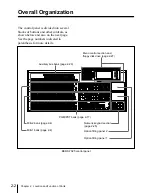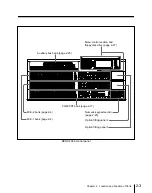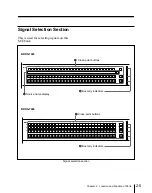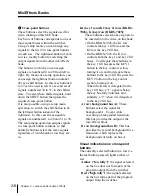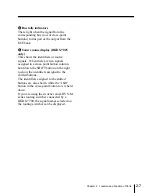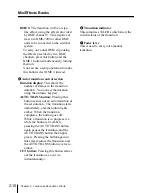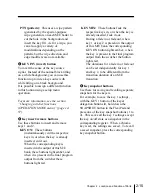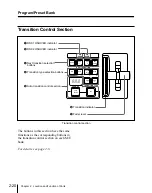
2-14
Chapter 2
Location and Function of Parts
Mix/Effects Banks
2
Key fill and key source selection
buttons
MATTE FILL: Pressing this button,
turning it on, selects a color matte
produced by the switcher as the key
fill signal.
When this button is off, the signal
selected on the key fill bus is used as
the key fill. When all three of this
button, the AUTO SEL button and the
SPLIT button are off, the signal
selected on the key fill bus is also
used as the key source (self-keying).
AUTO SEL (auto selection): Press this
button, turning it on, to use the signal
assigned in a setup menu to the
current key fill as the key source.
SPLIT: Press this button, turning it on,
to use the signal on the key source
bus as the key source. To select the
signal on the key source bus, hold
down this button, and press a cross-
point button in the auxiliary bus bank
or in the M/E bank a cross-point
button in the K row (BKDS-7025) or
K1 or K2 row (BKDS-7026).
To use the signal selected on the key
fill bus as the key source, press both
the SPLIT button and the AUTO SEL
button simultaneously, so that both
are off.
3
Key type selection buttons
LUM (luminance): A hole is cut at a
certain level of the Y (luminance)
signal of the key source, and the key
fill signal inserted.
• In a D2 system, the key source is
passed through a filter, and the
resulting Y signal is used to
determine the key.
• In a D1 system, the key source Y
signal is passed through a filter to
apply S-curve compensation, and the
resulting signal is used to determine
the key.
LIN (linear): A hole is cut in the
background and the key fill signal
inserted. Compared with a luminance
key, there is a reduced variability in
gain.
• In a D2 system, the key source
signal including the chrominance
component is used to determine the
key.
• In a D1 system, the key source Y
signal is used to determine the key.
CLEAN: In a luminance or linear key
the key source is used as a mask on
both the background (i.e. to cut the
hole) and on the key fill (i.e.
trimming it to fill the hole). The
clean key technique, on the other
hand, does not mask the key fill, but
simply mixes it with the background
from which the hole has been cut.
This means that the key fill signal
must already be trimmed to fit the
hole (i.e. black everywhere else).
CHR (chroma key): A particular hue
(usually blue) in the key source signal
is used to determine the hole to be cut
in the background.
You can use the following signals as
chroma key signals (foreground).
• In a D2 system: an analog
component signal (this requires the
optional BKDS-7133 chroma key
analog component input board).
• In a D1 system: an analog
component signal (this requires the
BKDS-7133 option), or a primary
input.
Summary of Contents for DVS-7250
Page 10: ......
Page 30: ......
Page 66: ......
Page 67: ...Menu Organization 3 2 Basic Menu Operations 3 6 Chapter 3 Basic Menu Operations ...
Page 274: ......
Page 328: ......
Page 364: ......
Page 488: ......
Page 495: ...Appendixes A 3 Enhanced Wipes 21 23 24 26 27 29 49 300 301 302 303 304 POLYGON ...
Page 534: ......
Page 542: ...Sony Corporation B P Company BZS 7061A WW A AE0 600 01 1 1999 ...



